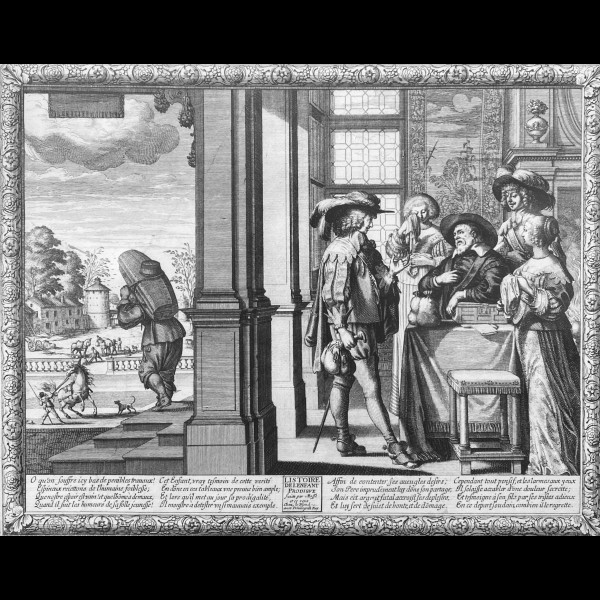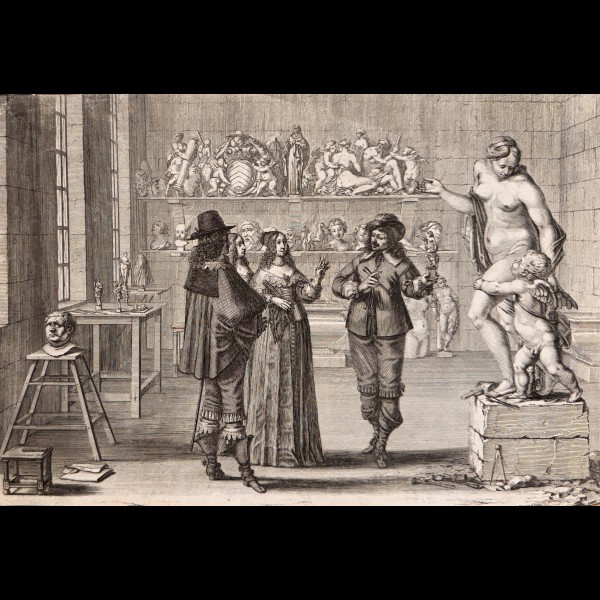BOSSE ABRAHAM ( 1605-1678 )
HISTOIRE DE L'ENFANT PRODIGUE
Complete suite of six framed prints (Blum: 1184-1189; Duplessis: 34-39) in a homogeneous edition, all with margins or margins with the exception of the Festin cut at the limit of the border. -The Prodigal Son leaves the paternal home Skillfully restored transverse tear, fine dubbing, tiny brown stain. -The Prodigal Son in a bawdy-house, uncovered version State II / III before the modifications on the panties of the man in the kitchen and the recovery on the hand of the Prodigal Son to make the board more "decent". On this piece the mention "du Roy"as well as the address of the publisher undoubtedly erased because of its scabrous character and re-established in the last version considered more suitable. Two old traces of brown ink in the most nimble places. -The Prodigal Son keeps the pigs Tiny brown spot in the border. -The Return of the Prodigal Son -The Prodigal Son changes his clothes Two traces of pencil in the sky and on the column. -The Feast of the Return The parable of the Prodigal Son is the subject of almost the entire chapter XV of the Gospel according to Saint Luke. Bosse respects the letter but he nevertheless watered down the end as was previously the case with many other artists very inspired by this theme, such Dürer, Beham, Mérian (who was one of the masters of the Bosse) or Callot whose slightly earlier sequel maintains a discreet relationship with it. (cf.: Abraham Bosse, learned engraver, BNF, Museum of Fine Arts in Tours, 2004)Each, at sight approximately 250 x 320 mmWith the frame 405 x 460 mm..
2,400.00 €
LE SCULPTEUR DANS SON ATELIER
Beautiful print trimmed to the edge of the square line, the upper left corner redone.1642Blum: 204"In his studio, a sculptor receives three visitors, two women and a man, elegantly dressed. One of the women is ecstatic before a large marble statue of Venus and Cupid standing on a pedestal to the right. On the pedestal are a mallet and a chisel, against it a compass, and on the ground clasps (a type of gouge) and a brush. The statue is reminiscent of the work of the sculptor Jacques Sarazin (1592-1660), notably the groups created for the Château de Wideville, on which the architect Thomas Francini also collaborated. The sculptor, who holds a chisel in his right hand, presents with his left the miniature model that served as a guide for the creation of his marble statue.To the left, on a stand, is a man's head; on a table behind, several wax models, wax on paper, and a modeling tool; behind it, on a small table, two wax models, one of which, in progress, is covered with a damp cloth to prevent it from drying out too quickly. On shelves at the back of the studio, as well as on the floor, are various examples of our sculptor's work. On the left, we notice a statue of Strength, and on the right, a group with a river god; between the two, a cartouche carved with the coat of arms of Cardinal Richelieu. Behind the visitors, a funerary sculpture can be partially seen."Abraham Bosse and the Royal Academy"Reason above all" by Sophie Join-Lambert, an article written as part of "Abraham Bosse, learned engraver" at the Bibliothèque nationale de France from April 20 to July 11, 2004...
380.00 €


